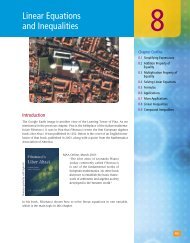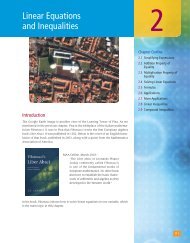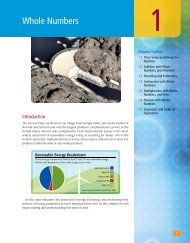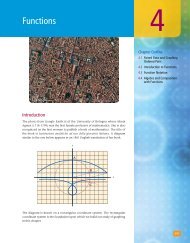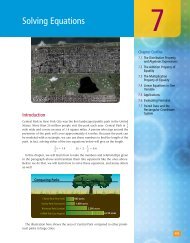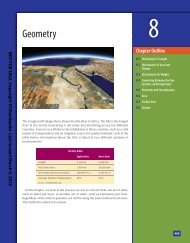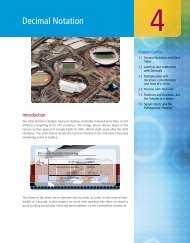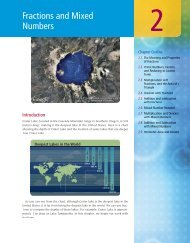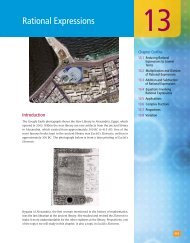Percent - XYZ Custom Plus
Percent - XYZ Custom Plus
Percent - XYZ Custom Plus
- No tags were found...
You also want an ePaper? Increase the reach of your titles
YUMPU automatically turns print PDFs into web optimized ePapers that Google loves.
348Chapter 5 <strong>Percent</strong>The new principal is $10,302.25 + $154.53 = $10,456.78. Interest for the fourthquarter isI = $10,456.78 × 0.06 × _1 Fourth quarter4I = $156.85To the nearest centThe total amount of money in this account at the end of 1 year isU s i n g$10,456.78 + $156.85 = $10,613.63T e c h n o l o g yCompound Interest from a FormulaWe can summarize the work above with a formula that allows us to calculatecompound interest for any interest rate and any number of compounding periods.If we invest P dollars at an annual interest rate r, compounded n timesa year, then the amount of money in the account after t years is given by theformulaA = P 1 + r _n nt Using numbers from Example 6 to illustrate, we haveP = Principal = $10,000r = annual interest rate = 0.06n = number of compounding periods = 4 (interest is compoundedquarterly)t = number of years = 1Substituting these numbers into the formula above, we haveNoteThe reason that thisanswer is differentfrom the result weobtained in Example 6 is that, inExample 6, we rounded each calculationas we did it. The calculatorwill keep all the digits in all of theintermediate calculations.A = 10,000 1 + _0.064×14 = 10,000(1 + 0.015) 4= 10,000(1.015) 4To simplify this last expression on a calculator, we haveScientific calculator: 10,000 × 1.015 y x 4 =Graphing calculator: 10,000 × 1.015 ^ 4 ENTERIn either case, the answer is $10,613.63551, which rounds to $10,613.64.Answer6. $21,648.64Getting Ready for ClassAfter reading through the preceding section, respond in your ownwords and in complete sentences.1. Suppose the man in Example 1 invested $3,000, instead of $2,000, in thesavings plan. How much more interest would he have earned?2. How much does the student in Example 3 pay back if the loan is paid offafter a year, instead of after 60 days?3. Suppose the homemaker mentioned in Example 5 invests $3,000 in anaccount that pays only 3_1 % compounded annually. How much is in the2account at the end of 2 years?4. In Example 6, how much money would the account contain at the end of1 year if it were compounded annually, instead of quarterly?



